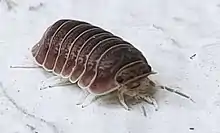| Cubaris murina | |
|---|---|
 | |
| Scientific classification | |
| Domain: | Eukaryota |
| Kingdom: | Animalia |
| Phylum: | Arthropoda |
| Class: | Malacostraca |
| Superorder: | Peracarida |
| Order: | Isopoda |
| Suborder: | Oniscidea |
| Family: | Armadillidae |
| Genus: | Cubaris |
| Species: | C. murina |
| Binomial name | |
| Cubaris murina Brandt, 1833 | |
Cubaris murina (commonly known as the little pillbug) is a species of woodlouse in the family Armadillidae. It is found in North America, Africa, South America, Australasia, tropical Asia, and the Pacific Ocean.[1][2][3]
Cubaris murina is a species that conglobates.
Cubaris murina has become popular as a pet in the exotic animal hobby. They have practical applications in improving the health of terrariums by serving as a bioactive clean-up crew, and are also valued for the attractive appearance of some of its color morphs (slang for observed Polymorphism). Known morphs of Cubaris murina in hobbyist collections include:
- Papaya - A dull pink variety that is believed by some to be the expression of some form of albinism
- Glacier - An almost completely white variety of Cubaris murina
- Anemone
References
- ↑ "Cubaris murina Report". Integrated Taxonomic Information System. Retrieved 2019-09-23.
- ↑ "Cubaris murina". GBIF. Retrieved 2019-09-23.
- ↑ "Cubaris murina species Information". BugGuide.net. Retrieved 2019-09-23.
This article is issued from Wikipedia. The text is licensed under Creative Commons - Attribution - Sharealike. Additional terms may apply for the media files.